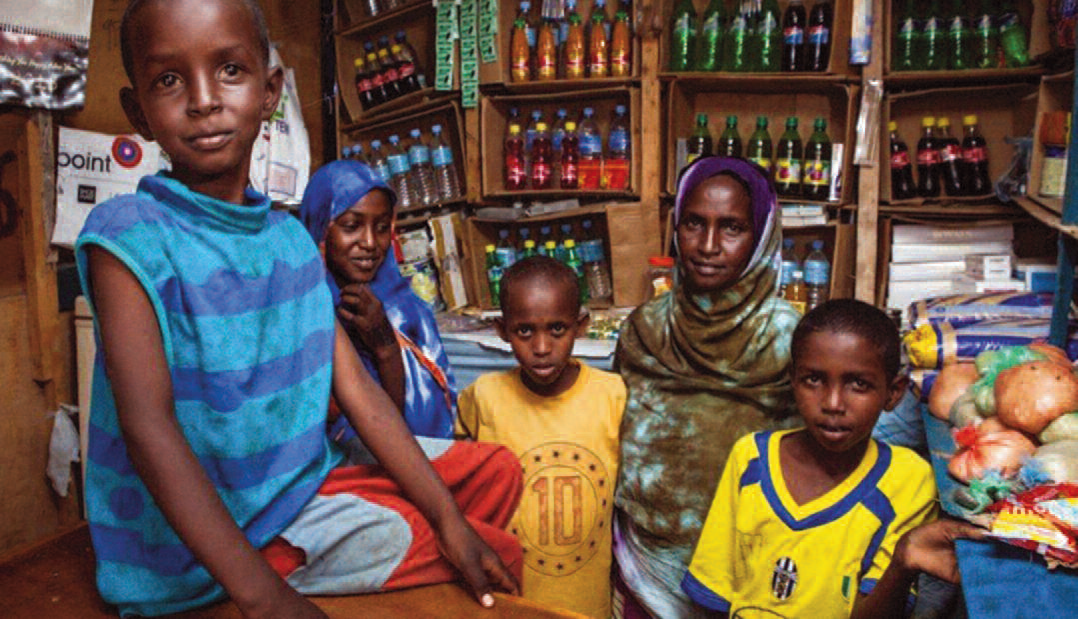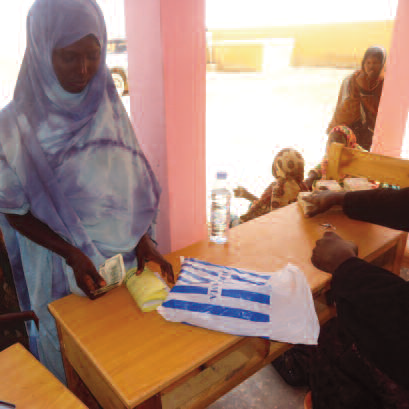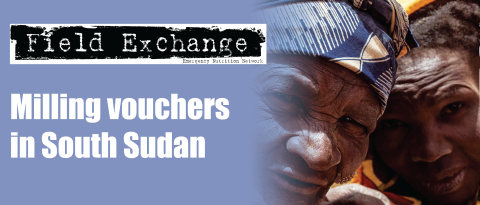Sectoral integration ‘on the cheap’ with cash based programming
 By Holly Welcome Radice
By Holly Welcome Radice
Holly Welcome Radice has worked for 15 years in food security programming in Africa and Latin America. She was the Head of Food Security and Livelihoods for Save the Children’s Somalia/Somaliland country programme from 2011 to early 2014.
The author would like to thank the Save the Children Somalia/Somaliland education, child protections and Puntland Food Security and Livelihoods teams, as their tireless implementation of the work contributed to this article.
Location: Somalia/Somaliland
What we know: Many agencies strive to implement integrated multi-sectoral programming. In practice, this is difficult to achieve.
 What this article adds: Using cash based programme as the aid modality, Save the Children Somalia has achieved education impact in a food security programme, food security impact through an education initiative, and livelihoods impact targeted through a child protection project. Well planned cash based programming enables beneficiary-led, multi-sectoral integration, and reduces the agency administrative burden to achieve this.
What this article adds: Using cash based programme as the aid modality, Save the Children Somalia has achieved education impact in a food security programme, food security impact through an education initiative, and livelihoods impact targeted through a child protection project. Well planned cash based programming enables beneficiary-led, multi-sectoral integration, and reduces the agency administrative burden to achieve this.
Integration of different sectors into one programme seems the obvious answer to meet diverse needs faced by households in humanitarian crisis. But integrated programmes often happen more in theory and less in practice. Multi-sectoral projects, with activities running side by side, are the norm rather than situations where needy households can have more than one of their needs addressed within the same humanitarian project. While integrated programmes might suggest greater overall efficiency, there is little evidence to support or dispel this hypothesis1.
 Furthermore, by design, funding constraints or the need to balance work across geographic areas, practical sectoral integration is often not achieved. Cash based programming (CBP), however, does lend itself very easily to “hidden” integration effected through one modality. Save The Children Somalia/Somaliland has seen that CBP is one easy way to integrate sector objectives and shares some experiences in this article.
Furthermore, by design, funding constraints or the need to balance work across geographic areas, practical sectoral integration is often not achieved. Cash based programming (CBP), however, does lend itself very easily to “hidden” integration effected through one modality. Save The Children Somalia/Somaliland has seen that CBP is one easy way to integrate sector objectives and shares some experiences in this article.
CBP in Somalia
Save the Children has been implementing CBP in Somalia since 2005. A variety of CBP modalities have been used including:
- unconditional cash relief
- conditional grants (cash for work, business grants, community level disaster risk reduction activities)
- vouchers for services (e.g. animal health treatment)
- vouchers for commodities (e.g. food, restocking of goats)
Save the Children has used CBP in rapid onset disasters such as floods and tsunamis, slow onset disasters such as droughts, and longer-term safety net programmes. Most of the CBP has used the hawala2 transfer system. In some remote areas of Puntland, Save the Children has made agreements with local cash facilitators to pre-finance cash transfers in the absence of available hawalas. Most recently, Save the Children has piloted the use of mobile phones for e-transfers, which is growing in use and as a means for humanitarian actors to implement CBP in Somalia.
The diversity of delivery modalities is overshadowed by the fact that the CBP has almost exclusively been implemented in the food security and livelihood sector. This is not unique to Save the Children or Somalia but is a common feature in many countries. Given that Save the Children’s country programme has seven sectors, integration seems like a natural objective, but has been met with only partial success. However, monitoring data shows that CBP has significantly contributed to other sectors and fostered integration as an unintended, positive benefit.
Education supporting food security
An emergency education project in Galgaduud, Central Somalia used food vouchers, which contributed to household food security, as an incentive for school attendance of children. Children enrolled in 24 Save the Children supported schools were required to reach a minimum of 85% attendance over three months for his/her household to qualify for the vouchers. All 3,176 students (1,975 households) qualified for the one-off voucher scheme. The intervention supported approximately 17% of the learners enrolled in the region3. Some 27 villages were represented in this activity including six internally displaced population (IDP) areas. Exact commodities for voucher exchange were decided at the local level through community educational committees. Local businesses were then selected to provide the supplies through a reimbursable voucher to Save the Children.
The food vouchers were distributed during a critical period - the long hunger gap. The value was designed to meet 30% of the food part of the Minimum Expenditure Basket (MEB)4 for Galgaduud Region. According to the registration data, nearly 50% of the students were from the same households; therefore nearly half of the households received 60% of the food portion of the MEB. The food received through the vouchers scheme lasted for 35 meals on average or approximately 17 days5.
In the following year, there was a 41% increase in school enrolment of boys and girls. This increase would have constituted an estimated 6% increase on the global regional enrolment6. Staff observations attributed this partly to the food vouchers. This increase in enrolment is extremely encouraging in a region were only 4% of boys and girls have completed formal schooling7.
Food security supporting education
In response to the 2011 crisis in Somalia, Save the Children implemented an emergency project in the remote district of Ishkushaban, Puntland. The objective was that targeted households would improve their access to basic food and non-food needs.
One activity in the project provided unconditional cash transfers to 333 drought affected households (1,888 people). The three villages were selected based on their vulnerability (e.g. severity of drought, number of IDPs and destitute pastoralists), connection to functional markets, and presence or non-presence of other actors. Sensitisation and beneficiary selection was undertaken with guidance for local authorities and village elders and ultimately village relief committees. The latter group was charged with the actual selection of potential households based on criteria jointly agreed upon by the communities and Save the Children field staff.
Community lists of potential beneficiaries were later verified through visits to a sample of recommended households by Save the Children staff. In addition, the lists were read publically at village based meetings with beneficiaries and non-beneficiaries, where communities were able to verify the eligibility of selected households.
Each household received US$85 for six consecutive months using hawalas. This amount corresponded to an average of 45% of the full MEB for Bari Region with considerable variation over the six months (48-63%) as market prices changed significantly during the period.
While the activity was aimed at promoting food security, the beneficiaries dictated their priorities. Throughout the distribution period, an average of 18% of the grant was used for school fees - second only to food expenditures. Between 70-90% of the households claimed to use part of the grant for education expenses. The beneficiaries demonstrated through their choices that underlying causes of vulnerability (in this case, lack of education) can be addressed in a humanitarian intervention without detracting from the original food security objectives.
An external evaluation confirmed the importance communities put on the use of cash relief for education. The headmaster of one of the villages stated:
“This project is good. It has helped mothers to pay the tuition fee on time. As a result of this project, the number of school enrolments were increased and fee defaulting reduced.”8
Livelihoods supporting child protection
CBP can indirectly have positive child protection outcomes9. In urban Hargeisa in Somaliland, Save the Children launched a livelihoods cash grant activity through a child protection project. The project is based in three IDP settlements in Hargeisa and targets approximately 140 households with one off cash grants for livelihood / income generating activities received via hawalas. Grants have varied depending on the enterprise proposed by the household and ranged from US$250-400. Prior to receiving the grants, households received a short business training.
Beneficiary households were targeted from the overall beneficiaries already receiving child protection support from Save the Children and its partners. From this pool of potential beneficiaries, Save the Children and its partners worked with community level groups to further identify households that were likely to have positive child protection outcomes from the grant and had earning capacity, among other criteria.
Monitoring from the pilot phase showed an immediate positive impact, with at risk children being enrolled in school, eating more meals a day and no longer being sent to beg or work for the family.
Integration through modalities instead of standalone activities
Most non-governmental organisations (NGOs) now strive to implement integrated multi-sectoral programming; perhaps the means to do so is by changing the approach and modality. Because of CBP’s inherent flexibility, households can decide on priority spends for cash, which inevitably span across the many needs that they have. Truly integrated projects or programmes may be practically difficult to achieve on the ground. Save the Children’s experience shows that a well-planned CBP activity may foster integration led by beneficiaries with no additional need for administrative direction.
For more information, contact: Ilaria Manunza, Deputy Director of Programme Quality, Save the Children Somalia / Somaliland, Ilaria.Manunza@savethechildren.org or Holly Welcome Radice, email: holly.radice@savethechildren.org or hwradice@yahoo.com or +254 733 444 092.
1Global Evidence of Good Practice for Integrated Humanitarian and Development Programming. Internal report. Save the Children Somalia. 2013
2Private money transfer systems that are very common in Somalia. They are used in a context that lacks a formal banking system.
3Somalia Education Cluster data. December 2013
4The Food Security & Nutrition Analysis Unit in FAO Somalia developed the minimum expenditure basket (MEB), consisting of minimum quantities of essential and basic food and non-food items. It represents a minimum set of basic food items comprising 2,100 kilocalories/person/day for a household of 6–7 and non-food items such as such as water, kerosene, firewood, soap and cereal grinding costs. It is monitored monthly for all regions of Somalia. The food part of the MEB is approximately 70% on average.
5Based on baseline data of an average of two meals per day.
6Somalia Education Cluster data. December 2013
7Assessment of education, livelihoods, living conditions and welfare of Somali pastoralists. Roy Car-Hill and David Ondijo. 2011
8Evaluation report on Save the Children Somaliland/Somalia food crisis response project–cash grants and livelihood asset protection in Iskushuban, Bari region, Puntland. Smart Vision. May 2012
9Cash and child protection. Save the Children. 2012.


 English
English Français
Français Deutsch
Deutsch Italiano
Italiano Español
Español